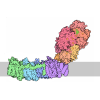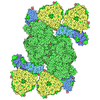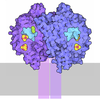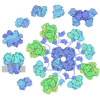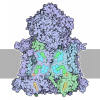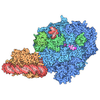+ Open data
Open data
- Basic information
Basic information
| Entry | Database: PDB / ID: 7p5h | ||||||||||||
|---|---|---|---|---|---|---|---|---|---|---|---|---|---|
| Title | TmHydABC- D2 map | ||||||||||||
 Components Components | (Fe-hydrogenase, subunit ...) x 3 | ||||||||||||
 Keywords Keywords | OXIDOREDUCTASE / Hydrogenase / bifurcation / confurcaction / cryoEM / electron transfer / complex | ||||||||||||
| Function / homology |  Function and homology information Function and homology informationhydrogenase (NAD+, ferredoxin) / NADH dehydrogenase (ubiquinone) activity / ATP synthesis coupled electron transport / 2 iron, 2 sulfur cluster binding / FMN binding / 4 iron, 4 sulfur cluster binding / oxidoreductase activity / metal ion binding / membrane / cytoplasm Similarity search - Function | ||||||||||||
| Biological species |   Thermotoga maritima (bacteria) Thermotoga maritima (bacteria) | ||||||||||||
| Method | ELECTRON MICROSCOPY / single particle reconstruction / cryo EM / Resolution: 2.3 Å | ||||||||||||
 Authors Authors | Furlan, C. / Chongdar, N. / Gupta, P. / Lubitz, W. / Ogata, H. / Blaza, J.N. / Birrell, J.A. | ||||||||||||
| Funding support |  United Kingdom, United Kingdom,  Germany, Germany,  Japan, 3items Japan, 3items
| ||||||||||||
 Citation Citation |  Journal: Elife / Year: 2022 Journal: Elife / Year: 2022Title: Structural insight on the mechanism of an electron-bifurcating [FeFe] hydrogenase. Authors: Chris Furlan / Nipa Chongdar / Pooja Gupta / Wolfgang Lubitz / Hideaki Ogata / James N Blaza / James A Birrell /    Abstract: Electron bifurcation is a fundamental energy conservation mechanism in nature in which two electrons from an intermediate-potential electron donor are split so that one is sent along a high-potential ...Electron bifurcation is a fundamental energy conservation mechanism in nature in which two electrons from an intermediate-potential electron donor are split so that one is sent along a high-potential pathway to a high-potential acceptor and the other is sent along a low-potential pathway to a low-potential acceptor. This process allows endergonic reactions to be driven by exergonic ones and is an alternative, less recognized, mechanism of energy coupling to the well-known chemiosmotic principle. The electron-bifurcating [FeFe] hydrogenase from (HydABC) requires both NADH and ferredoxin to reduce protons generating hydrogen. The mechanism of electron bifurcation in HydABC remains enigmatic in spite of intense research efforts over the last few years. Structural information may provide the basis for a better understanding of spectroscopic and functional information. Here, we present a 2.3 Å electron cryo-microscopy structure of HydABC. The structure shows a heterododecamer composed of two independent 'halves' each made of two strongly interacting HydABC heterotrimers connected via a [4Fe-4S] cluster. A central electron transfer pathway connects the active sites for NADH oxidation and for proton reduction. We identified two conformations of a flexible iron-sulfur cluster domain: a 'closed bridge' and an 'open bridge' conformation, where a Zn site may act as a 'hinge' allowing domain movement. Based on these structural revelations, we propose a possible mechanism of electron bifurcation in HydABC where the flavin mononucleotide serves a dual role as both the electron bifurcation center and as the NAD reduction/NADH oxidation site. | ||||||||||||
| History |
|
- Structure visualization
Structure visualization
| Structure viewer | Molecule:  Molmil Molmil Jmol/JSmol Jmol/JSmol |
|---|
- Downloads & links
Downloads & links
- Download
Download
| PDBx/mmCIF format |  7p5h.cif.gz 7p5h.cif.gz | 1.6 MB | Display |  PDBx/mmCIF format PDBx/mmCIF format |
|---|---|---|---|---|
| PDB format |  pdb7p5h.ent.gz pdb7p5h.ent.gz | 1.4 MB | Display |  PDB format PDB format |
| PDBx/mmJSON format |  7p5h.json.gz 7p5h.json.gz | Tree view |  PDBx/mmJSON format PDBx/mmJSON format | |
| Others |  Other downloads Other downloads |
-Validation report
| Summary document |  7p5h_validation.pdf.gz 7p5h_validation.pdf.gz | 1.4 MB | Display |  wwPDB validaton report wwPDB validaton report |
|---|---|---|---|---|
| Full document |  7p5h_full_validation.pdf.gz 7p5h_full_validation.pdf.gz | 1.5 MB | Display | |
| Data in XML |  7p5h_validation.xml.gz 7p5h_validation.xml.gz | 125.2 KB | Display | |
| Data in CIF |  7p5h_validation.cif.gz 7p5h_validation.cif.gz | 201.3 KB | Display | |
| Arichive directory |  https://data.pdbj.org/pub/pdb/validation_reports/p5/7p5h https://data.pdbj.org/pub/pdb/validation_reports/p5/7p5h ftp://data.pdbj.org/pub/pdb/validation_reports/p5/7p5h ftp://data.pdbj.org/pub/pdb/validation_reports/p5/7p5h | HTTPS FTP |
-Related structure data
| Related structure data |  13199MC  7p8nC  7p91C  7p92C M: map data used to model this data C: citing same article ( |
|---|---|
| Similar structure data | Similarity search - Function & homology  F&H Search F&H Search |
- Links
Links
- Assembly
Assembly
| Deposited unit | 
|
|---|---|
| 1 |
|
- Components
Components
-Fe-hydrogenase, subunit ... , 3 types, 12 molecules ADadBEbeCFcf
| #1: Protein | Mass: 72351.391 Da / Num. of mol.: 4 Source method: isolated from a genetically manipulated source Source: (gene. exp.)   Thermotoga maritima (strain ATCC 43589 / DSM 3109 / JCM 10099 / NBRC 100826 / MSB8) (bacteria) Thermotoga maritima (strain ATCC 43589 / DSM 3109 / JCM 10099 / NBRC 100826 / MSB8) (bacteria)Strain: ATCC 43589 / DSM 3109 / JCM 10099 / NBRC 100826 / MSB8 Gene: TM_1426, HydA Production host:  References: UniProt: G4FFG1, hydrogenase (NAD+, ferredoxin) #2: Protein | Mass: 68769.406 Da / Num. of mol.: 4 Source method: isolated from a genetically manipulated source Source: (gene. exp.)   Thermotoga maritima (strain ATCC 43589 / DSM 3109 / JCM 10099 / NBRC 100826 / MSB8) (bacteria) Thermotoga maritima (strain ATCC 43589 / DSM 3109 / JCM 10099 / NBRC 100826 / MSB8) (bacteria)Strain: ATCC 43589 / DSM 3109 / JCM 10099 / NBRC 100826 / MSB8 Gene: TM_1425, HydB Production host:  References: UniProt: G4FFG0, hydrogenase (NAD+, ferredoxin) #3: Protein | Mass: 20941.172 Da / Num. of mol.: 4 Source method: isolated from a genetically manipulated source Details: M initiation codon AS is a linker WSHPQFEK strep tag SGGGGG is a linker ENLYFQ is tev sequence SA is a linker Source: (gene. exp.)   Thermotoga maritima (strain ATCC 43589 / DSM 3109 / JCM 10099 / NBRC 100826 / MSB8) (bacteria) Thermotoga maritima (strain ATCC 43589 / DSM 3109 / JCM 10099 / NBRC 100826 / MSB8) (bacteria)Strain: ATCC 43589 / DSM 3109 / JCM 10099 / NBRC 100826 / MSB8 Gene: TM_1424, HydC Production host:  References: UniProt: Q9S5X7, hydrogenase (NAD+, ferredoxin) |
|---|
-Non-polymers , 5 types, 680 molecules 








| #4: Chemical | ChemComp-SF4 / #5: Chemical | ChemComp-FES / #6: Chemical | ChemComp-FMN / #7: Chemical | ChemComp-ZN / #8: Water | ChemComp-HOH / | |
|---|
-Details
| Has ligand of interest | Y |
|---|---|
| Has protein modification | N |
-Experimental details
-Experiment
| Experiment | Method: ELECTRON MICROSCOPY |
|---|---|
| EM experiment | Aggregation state: PARTICLE / 3D reconstruction method: single particle reconstruction |
- Sample preparation
Sample preparation
| Component | Name: Tetrameric complex of HydABC protomers / Type: COMPLEX / Entity ID: #1-#3 / Source: RECOMBINANT | ||||||||||||
|---|---|---|---|---|---|---|---|---|---|---|---|---|---|
| Molecular weight | Value: 0.64 MDa / Experimental value: NO | ||||||||||||
| Source (natural) | Organism:   Thermotoga maritima MSB8 (bacteria) Thermotoga maritima MSB8 (bacteria) | ||||||||||||
| Source (recombinant) | Organism:  | ||||||||||||
| Buffer solution | pH: 8 | ||||||||||||
| Buffer component |
| ||||||||||||
| Specimen | Conc.: 1 mg/ml / Embedding applied: NO / Shadowing applied: NO / Staining applied: NO / Vitrification applied: YES / Details: Purified by gel filtration | ||||||||||||
| Specimen support | Grid material: GOLD / Grid mesh size: 300 divisions/in. / Grid type: UltrAuFoil R1.2/1.3 | ||||||||||||
| Vitrification | Instrument: FEI VITROBOT MARK IV / Cryogen name: ETHANE / Humidity: 100 % / Chamber temperature: 277.15 K |
- Electron microscopy imaging
Electron microscopy imaging
| Experimental equipment |  Model: Titan Krios / Image courtesy: FEI Company |
|---|---|
| Microscopy | Model: FEI TITAN KRIOS |
| Electron gun | Electron source:  FIELD EMISSION GUN / Accelerating voltage: 300 kV / Illumination mode: FLOOD BEAM FIELD EMISSION GUN / Accelerating voltage: 300 kV / Illumination mode: FLOOD BEAM |
| Electron lens | Mode: BRIGHT FIELD / Nominal magnification: 165000 X / Calibrated magnification: 60700 X / Nominal defocus max: 3000 nm / Nominal defocus min: 1000 nm / Cs: 2.7 mm / C2 aperture diameter: 70 µm / Alignment procedure: COMA FREE |
| Specimen holder | Cryogen: NITROGEN / Specimen holder model: FEI TITAN KRIOS AUTOGRID HOLDER |
| Image recording | Average exposure time: 6 sec. / Electron dose: 57 e/Å2 / Detector mode: COUNTING / Film or detector model: GATAN K2 SUMMIT (4k x 4k) / Num. of real images: 4790 |
- Processing
Processing
| Software | Name: PHENIX / Version: 1.19.2_4158: / Classification: refinement | ||||||||||||||||||||||||||||
|---|---|---|---|---|---|---|---|---|---|---|---|---|---|---|---|---|---|---|---|---|---|---|---|---|---|---|---|---|---|
| EM software |
| ||||||||||||||||||||||||||||
| CTF correction | Type: PHASE FLIPPING AND AMPLITUDE CORRECTION | ||||||||||||||||||||||||||||
| Particle selection | Num. of particles selected: 885306 | ||||||||||||||||||||||||||||
| Symmetry | Point symmetry: D2 (2x2 fold dihedral) | ||||||||||||||||||||||||||||
| 3D reconstruction | Resolution: 2.3 Å / Resolution method: FSC 0.143 CUT-OFF / Num. of particles: 278793 / Algorithm: FOURIER SPACE / Symmetry type: POINT | ||||||||||||||||||||||||||||
| Atomic model building | Protocol: FLEXIBLE FIT / Space: REAL | ||||||||||||||||||||||||||||
| Refine LS restraints |
|
 Movie
Movie Controller
Controller






 PDBj
PDBj
